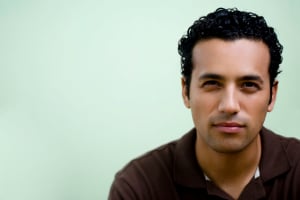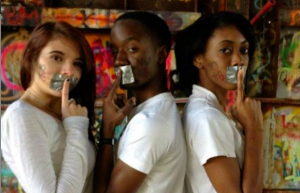Originally published on Medium and republished here with the author’s permission.
(CN: mention of suicide and self-harm)

Closeup of a person with bright red lipstick gazing into the camera.
Identifying as intersex is a radical process. For a lot of us, there is an “aha!” moment when we discover the term for the first time – it usually involves connecting the dots between our bodies and an identity.
It completely changed me; I felt that I had agency over my body for the first time in my life.
I remember sitting on the floor of my first apartment late at night, secretly researching the “deformity” that I had kept hidden throughout my life. I felt alone in my experiences, and almost never discussed what I had been through with anyone. It goes without saying that I was still very emotionally scarred from my traumatic medical history.
One click led to another, and I found myself reading The Intersex Roadshow, a blog by Cary Costello. The particular post I read pointed out the ways that society hides intersex identity from people who are designated male at birth and have intersex traits, and instead labels these bodies as “deformed” or merely “inadequate,” rather than somewhere along the spectrum of sex.
I could barely finish it, being met head-on with ideas that shook the foundation of my identity. I began rapidly shuffling through my experiences and the ways I thought about myself.
Staring blankly at my laptop screen, I realized: Shit, he was talking about me. “How could I have not known about this?” I kept asking myself.
In the following days, I devoured as much information as possible on everything intersex related, making up for years spent in the dark. Once I started identifying as intersex, I was able to begin the healing process. I no longer blamed myself for the way I was – because I learned that there was nothing wrong with it.
Instead, I was furious at the people who tried, and nearly succeeded, to erase my differences with a scalpel and never provided me with alternatives after multiple surgeries.
Growing up, I believed I must have a “normal” body or I will never be loved. I learned at a young age to turn away from anyone who got too close, fearing they would find out what a horrible abomination I really was. The fears were affirmed at the age of twelve when I received abuse from my peers after entrusting them with the truth, being told to kill myself for weeks on end.
The years of emotional torture I suffered through because of the stigma towards intersex bodies could have been aided if someone would have provided support, or really had done basically anything other than idly watch me waste away. Even family did nothing as I declined into a deep, suicidal depression.
When intersex people are given a “diagnosis,” we are often left with more questions than answers. Since the abolition of using “intersex” in medical contexts, it has become more difficult to destigmatize intersex traits. The new umbrella terminology, “Disorders of Sex Development” or DSD, makes it easier to pathologize and “treat” us since a disorder is generally considered something that should be fixed. This lands the doctors office faaaaar away from the access to a powerful identity and community.
Authoritative medical professionals with MDs and white coats also have incentive to remove the identity aspect of being intersex, and I believe that it is partly a ploy to keep intersex people and their families vulnerable.
The kind of vulnerable that handed me from my mother’s arms to the surgeon’s gloves, the kind of vulnerable that left my genitals a wasteland of scars, the kind of vulnerable that drove me to suicide and self-harm, the kind of vulnerable that put me back on the operating table.
Hospitals can’t make any money if there is nothing to operate on, and pharmaceutical companies can’t profit off of people who refuse hormonal therapy. It is also worth noting that these medical producers have been scrutinized by The UN Special Rapporteur on Torture and viewed as unethical and inhumane.
This is why I believe so strongly in intersex people determining the way we define our bodies, not medical professionals with their own interests in mind. We know our bodies best. We know we are not broken – we are beautiful.
[do_widget id=’text-101′]
Catherine Graffam is a 23-year-old intersex trans woman from New Hampshire. She is a visual artist and writer, as well as a proud cat mom. Her work is about identity, agency, and the reclamation of her body. You can find her on her website and follow her on Twitter @catgraffam.
Search our 3000+ articles!
Read our articles about:
Our online racial justice training
Used by hundreds of universities, non-profits, and businesses.
Click to learn more
Most Read Articles
- « Previous
- 1
- …
- 30
- 31
- 32



















